I was recently asked whether volatility was particularly challenging for index fund owners or for active investors. The answer is “yes.”
For index funds, the challenge arises because rising volatility typically accompanies poor returns. Between 1991 and 2019, e.g., months in which the S&P 500’s volatility was above median averaged modestly negative total returns. In contrast, when volatility was below median, monthly returns averaged 1.84%. This is entirely sensible – a stock, after all, should be valued at the discounted value of its future cash flows. In times of uncertainty, the discount rate rises, and prices fall accordingly. If investors are less certain of the future, they’re inclined to pay less for it.
Passive investors, accordingly, are likely to find high volatility damaging to the value of their portfolios; other than “this too shall pass,” it’s difficult to find anything to say in mitigation. For active investors, however, an interesting subtlety arises.
The ability of an active manager to add value depends most importantly on his skill level. But it also depends on how much opportunity the market presents. We can measure the level of opportunity by monitoring the market’s dispersion – i.e., the degree to which the returns of the stocks in a given index are close together or widely separated. Dispersion and volatility tend to move up and down together – other things equal, the more disperse returns are, the more volatile the market as a whole will be.
For much of the past decade, dispersion has been well below its average level. This is one of the reasons that active managers as a group have had such a difficult time outperforming passive benchmarks. In March, however, both volatility and dispersion spiked upward. We observe the same effect not only across global equity markets, but also when we measure dispersion across sectors, countries, and asset classes.
This means that the value added of a skillful (or lucky) active manager can be considerably larger in March 2020 than it would have been a year – or even a month – earlier. For less skillful (or unlucky) managers, the potential magnitude of underperformance is similarly magnified. In fact, preliminary data on first quarter performance note a widening gap between the top and bottom performing active managers.
All active managers are likely to see declining portfolio values, but some are likely to outperform the market to an above-average extent. For active managers (and the asset owners who employ them), volatility is a double-edged sword.
The posts on this blog are opinions, not advice. Please read our Disclaimers.








